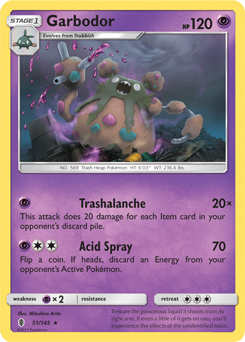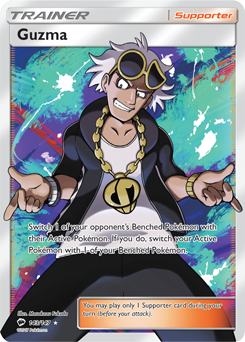Garbage Day — Why Garbodor is Still a Strong Choice in the New Standard

PokeBeach, it’s been a while. I’ve taken some time off from writing to give others a chance to write, since I wasn’t really going for an invite last season and we had a lot of writers that were more excited to write than I was! Since then, I’ve made day two at North American Internationals with Vikavolt / Tapu Bulu-GX. I went 7-2 on the first day, then did abysmal on day two with a 1-3-2 record. I recently went to Fort Wayne Regionals with a 5-4-0 record, starting out with two losses, then winning five in a row before losing my last two rounds. I luckily ended up in the top 256 so I earned some points.
So that’s what I’ve been up to lately. I’m preparing myself for Standard, even though I’m not going to Hartford. I have some League Cups in my area and I will be attending them to get myself some first quarter points. I will also be attending Daytona Beach Regionals in Florida, so be on the lookout for me there if you’re attending.
I’ve been loving the power of Garbodor from BREAKpoint in Standard. So many decks are Ability-driven; the loss of Hex Maniac helps these decks out a lot, but we can still hurt with Garbotoxin. Garbodor from Guardians Rising with Trashalanche is still solid even though every deck is playing four fewer Items with the loss of VS Seeker. Despite this change, Items are still the name of the game; in some ways, Garbodor is even more powerful now. The loss of VS Seeker impacts Standard in a huge way. It will feel markedly different if you haven’t tried Standard yet.
There are three common partners for Garbodor: Espeon-GX, Golisopod-GX, and Drampa-GX. Each have their nuances and their reasons for being played and all are fairly solid. I’ve been testing all three variants and have found that I do not particularly like any variant over the other. I will discuss two of these three decks, along with my lists for them. I will also discuss deck building in Standard and how different it is than what most of us are used to with VS Seeker being in the format for so long.
If you haven’t played Standard yet, give this a read and give it a shot. The format is brand new and largely unexplored.
Standard and Why You Should Still Play Garbodor
The Case for Garbodor
VS Seeker is gone, and decks play fewer Items in general now because of its disappearance. This doesn’t mean Garbodor‘s Trashalanche is that much worse. Decks still play many Items, and playing conservatively with N is not as much of an option anymore since VS Seeker rotated, thus causing players to involuntarily discard Items with Professor Sycamore instead.
Garbotoxin Garbodor is incredible now. Nearly every major deck relies on Abilities, and that means a lot of decks get significantly hurt by Garbotoxin. A 2-2 ratio of Trashalanche to Garbotoxin is surely the adjustment these decks need to make. We need to focus more on the disruption of Garbotoxin, while still keeping the late game damage potential of Trashalanche a possibility. This forces our opponents to play more wisely, and punishes players that are less skilled or aren’t used to playing against Garbodor. I also want to mention that it can be difficult for some decks to hit 120 damage without Abilities. A Volcanion-EX needs to waste a Volcanic Heat to take only one Prize off of a Garbodor.
The New Standards
One obvious change people are making to their decks right now is to replace their VS Seeker with more Supporter cards, but which ones? Professor Sycamore has almost always been run as a four-of already alongside two or three N and the loss of VS Seeker has caused players to increase their N counts to four. However, that often isn’t enough, especially when Garbotoxin is in play and your own Tapu Lele-GX can’t grab Supporters out of your deck.
Hala has been my third draw Supporter of choice. It’s not too great, but it’s incredible in Drampa-GX decks and even Espeon-GX decks, since both of those decks pop their GX attacks relatively early. I know others have been testing Lillie, but the turn one Brigette is still incredibly powerful. I’ve heard of others testing Sophocles as well.
I’d still rather play one copy of Hala than those other Supporters though, even in decks that don’t GX attack early. Chances are, when you draw your Hala, you will have used your GX attack already. In the context of Garbodor decks, GX attacks tend to be used within the first few turns. Golisopod-GX / Garbodor may be the exception to that rule, but it still often uses its GX attack sooner rather than later to make use of that immediate 150 hit-and-run damage.
Another card I want to mention that’s making an appearance in many decks is Octillery. Brigette becoming a staple has made Octillery so much easier to get out. Decks that play it get the advantage of having a slight Shaymin-EX effect every turn for the consequence of getting a single Stage 1 into play. Now, in Garbodor decks, that isn’t an option at all, due to Octillery being shut off by Garbotoxin. However, it’s something to consider in your Standard deck building in general, and is one unfortunate consequence of playing Garbodor decks.
I also want to mention that there are a ton of different deck combinations out there. I’ve seen different creative builds of partners that fit well with already well established cards such as Drampa-GX and Golisopod-GX. This is turning out to be a very healthy format as far as deck diversity goes.

However, it’s not without its problems. I’ve dead drawn quite a bit in this format, and I believe a lot of it stems from the rotation of VS Seeker. That’s an obvious statement and something that should be expected, but I want to stress how important it is to have something beyond your four Professor Sycamore, four N, and a few Tapu Lele-GX. You can’t skimp on consistency anymore, and the gold standard profile for building decks is gone now. We’ve had VS Seeker around since Phantom Forces and it’s been a part of deck building for as long as many of you have been playing the game. This current Standard format is a huge adjustment for many of you and it takes a few games to get used to it. I think I’ve dead drawn in this current format more often than I have in any past format that I could remember.
Lastly, I want to briefly go over the impact of Guzma. Guzma shouldn’t replace your Float Stone counts; rather, it should be more of a supplement to them. Guzma is a phenomenal card, and I’ve found myself playing four copies of it in many of my decks. I’ll discuss this a bit more later in the article when I go over my actual lists, but Guzma being a four-of should be considered, while three should be the current standard.
Now, I’m going to cover the two variants of Garbodor decks I’ve tested. I’m sure there are some of you that would like to hear about Golisopod-GX / Garbodor, but I haven’t tested that variant much at all and don’t feel like I can give a good assessment of it. I’ve been focusing my efforts on Espeon-GX and Drampa-GX. One of the reasons for that is that I feel that Fire decks are going to be played quite a bit, and Golisopod-GX struggles against those.
Espeon-GX / Garbodor
This is probably my favorite Garbodor variant since it gives you a lot of options. Espeon-GX has two solid attacks that control the game, and one excellent damage-dealing attack. Espeon-GX was an incredible deck last season. It was my number one pick going into Internationals until I got tipped off about the amount of Greninja and Turbo Darkrai-EX around, which caused me to switch to my backup deck, Vikavolt / Tapu Bulu-GX. That said, there are plenty of reasons Espeon-GX / Garbodor is still strong now. Let me go over some reasons why you’d consider this over Drampa-GX and Golisopod-GX.
This concludes the public portion of this article.
If you'd like to continue reading, consider purchasing a PokeBeach premium membership! If you're not completely satisfied with your membership, you can request a full refund within 30 days.
Each week we post high-quality content from some of the game's top players. Our article program isn't a corporate operation, advertising front, or for-profit business. We set our prices so that we can pay the game's top players to write the best content for our subscribers. Each article topic is carefully selected, goes through multiple drafts, and is touched up by our editors. We take great pride in our program!

